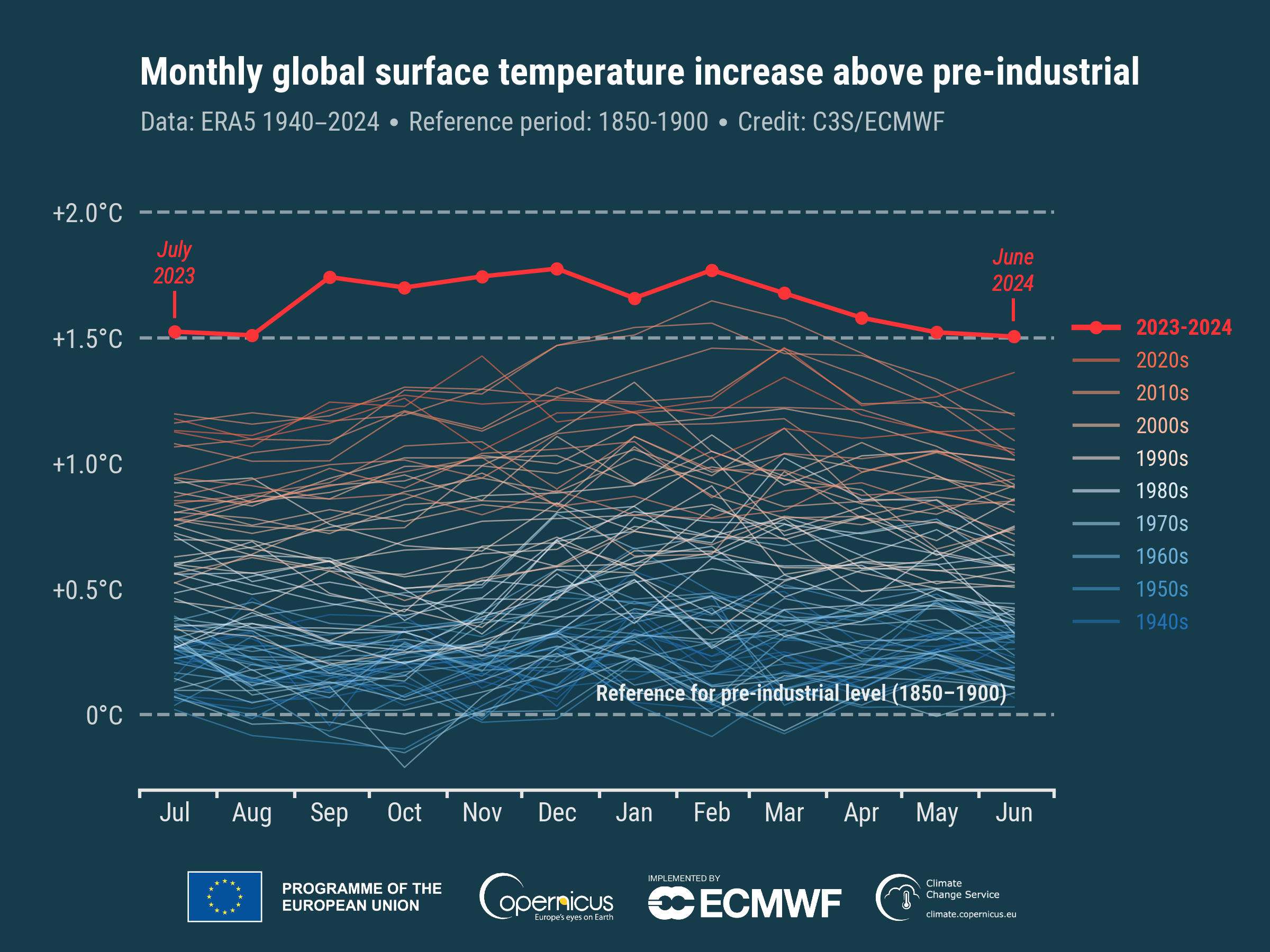June 2024 marks 12th month of global temperature reaching 1.5 C above pre-industrial

Shoppers walk in the heat at the Las Vegas North Premium Outlets Mall on June 27 shortly past 3:30 p.m. ZFJ/Alvin Wu
July 27 (ZFJ) — At 1.50 C (2.7 F) above the estimated June average for 1850-1900, June 2024 has become the 12th consecutive month to reach or break the 1.5 C threshold set by the Paris Agreement, according to the European Union’s Copernicus Climate Change Service (C3S).
With a surface air temperature of 16.66 C (61.99 F), June 2024 was warmer globally than any previous June in C3S’ ERA5 data record. It was 0.67 C (1.21 F) above the 1991-2020 average for June and 0.14 C (0.25 F) above the previous high in June 2023.
June 2024 is also the 13th month in a row that is the warmest in the ERA5 record for the respective month of a year. C3S comments that, while unusual, a similar streak of monthly global temperature records previously occurred in 2015-2016.
“This is more than a statistical oddity and it highlights a large and continuing shift in our climate,” said Carlo Buontempo, C3S director. “Even if this specific streak of extremes ends at some point, we are bound to see new records being broken as the climate continues to warm. This is inevitable, unless we stop adding greenhouse gases into the atmosphere and the oceans.”
The global average temperature for the past 12 months—July 2023-June 2024— is the highest on record, at 0.76 C (1.37 F) above the 1991-2020 average and 1.64 C (34.95 F) above the pre-industrial reference period’s average.
 Monthly global surface air temperature anomalies (°C) relative to 1850–1900 from January 1940 to June 2024, plotted as time series for all 12-month periods spanning July to June of the following year. The 12 months from July 2023 to June 2024 are shown with a thick red line, while all other 12-month periods are shown with thin lines shaded according to the decade, from blue (1940s) to brick red (2020s). Data source: ERA5. COPERNICUS CLIMATE CHANGE SERVICE/Handout
Monthly global surface air temperature anomalies (°C) relative to 1850–1900 from January 1940 to June 2024, plotted as time series for all 12-month periods spanning July to June of the following year. The 12 months from July 2023 to June 2024 are shown with a thick red line, while all other 12-month periods are shown with thin lines shaded according to the decade, from blue (1940s) to brick red (2020s). Data source: ERA5. COPERNICUS CLIMATE CHANGE SERVICE/Handout
The average European temperature for June 2024 was 1.57 C (2.83 F) above the 1991-2020 average for June, making it the joint second-warmest June on record for Europe.
The average temperature of the contiguous U.S. in June was 71.8 F (22.11 C), 3.4 F (1.89 C) above average, becoming the second warmest in the National Oceanic and Atmospheric Administration (NOAA)’s 130-year record.
NOAA, an American scientific agency, reports that about 24 million people across portions of the West, South, and Northeast experienced their warmest June for overnight temperatures.
 Shoppers walk in the heat at the Las Vegas North Premium Outlets Mall on June 27 shortly past 3:30 p.m. ZFJ/Alvin Wu
Shoppers walk in the heat at the Las Vegas North Premium Outlets Mall on June 27 shortly past 3:30 p.m. ZFJ/Alvin Wu
On June 30, Beryl became the earliest Category 4 hurricane and the only Category 4 on record during June in the Atlantic Ocean.
Arctic sea ice extent was 3% below average, close to the values observed most years since 2010, according to C3S. Antarctic sea ice extent was 12% below average, the second-lowest for June in the satellite data record, behind the lowest June value of -16% seen in June 2023.
References
- Copernicus Climate Change Service - Copernicus: June 2024 marks 12th month of global temperature reaching 1.5°C above pre-industrial - https://climate.copernicus.eu/copernicus-june-2024-marks-12th-month-global-temperature-reaching-15degc-above-pre-industrial (ARCHIVE)
- National Oceanic and Atmospheric Administration - Assessing the U.S. Climate in June 2024 - https://www.ncei.noaa.gov/news/national-climate-202406 (ARCHIVE)
